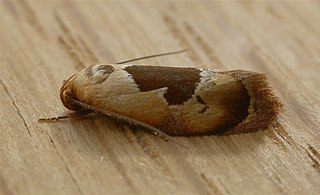Related Research Articles

Hoplomorpha camelaea is a moth in the family Oecophoridae first described by Edward Meyrick in 1888. It is found in Australia, where it has been recorded from Victoria, Queensland, New South Wales and the Australian Capital Territory.
Catacometes hemiscia is a moth in the family Oecophoridae. It was described by Edward Meyrick in 1883. It is found in Australia, where it has been recorded from New South Wales.
Ebbepterote is a monotypic moth genus in the family Eupterotidae. It was erected by Rolf G. Oberprieler, Wolfgang A. Nässig and Edward David Edwards in 2003. Its only species, Ebbepterote expansa, was described by Thomas Pennington Lucas in 1891. It is found in Australia, where it has been recorded from Queensland.
Dorycnopa heliochares is a moth of the family Gelechiidae. It was described by Oswald Bertram Lower in 1900. It is found in Australia, where it has been recorded from South Australia.
Zaphanaula hemileuca is a moth in the family Xyloryctidae, and the only species in the genus Zaphanaula. It was described by Turner in 1896. It is found in Australia, where it has been recorded from Queensland.
Cryptophasa opalina is a moth in the family Xyloryctidae. It was described by Turner in 1900. It is found in Australia, where it has been recorded from the Northern Territory, Queensland and Western Australia.
Cryptophasa tetrazona is a moth in the family Xyloryctidae. It was described by Oswald Bertram Lower in 1901. It is found in Australia, where it has been recorded from New South Wales, Queensland, Victoria and Western Australia.
Cryptophasa phycidoides is a moth in the family Xyloryctidae. It was described by Thomas Pennington Lucas in 1901. It is found in Australia, where it has been recorded from New South Wales and Queensland.
Pilostibes serpta is a moth in the family Xyloryctidae. It was described by Thomas Pennington Lucas in 1901. It is found in Australia, where it has been recorded from New South Wales, Queensland, South Australia and Western Australia.
Lichenaula arisema is a moth in the family Xyloryctidae. It was described by Edward Meyrick in 1890. It is found in Australia, where it has been recorded from New South Wales, South Australia and Victoria.

Lichenaula appropinquans is a moth in the family Xyloryctidae. It was described by Thomas Pennington Lucas in 1901. It is found in Australia, where it has been recorded from New South Wales and Queensland.
Plectophila eucrines is a moth in the family Xyloryctidae. It was described by Turner in 1898. It is found in Australia, where it has been recorded from and New South Wales and Queensland.
Plectophila micradelpha is a moth in the family Xyloryctidae. It was described by Turner in 1898. It is found in Australia, where it has been recorded from Queensland.
Plectophila pyrgodes is a moth in the family Xyloryctidae. It was described by Turner in 1898. It is found in Australia, where it has been recorded from New South Wales and Queensland.
Plectophila placocosma is a moth in the family Xyloryctidae. It was described by Oswald Bertram Lower in 1893. It is found in Australia, where it has been recorded from New South Wales.
Xylorycta chrysomela is a species of moth in the family Xyloryctidae. It was described by Oswald Bertram Lower in 1897. It is found in Australia, where it has been recorded from the Northern Territory and Queensland.
Xylorycta emarginata is a moth in the family Xyloryctidae. It was described by Thomas Pennington Lucas in 1900. It is found in Australia, where it has been recorded from Queensland.
Zauclophora procellosa is a moth in the family Xyloryctidae. It was described by Thomas Pennington Lucas in 1901. It is found in Australia, where it has been recorded from Queensland.
Lichenaula provisa is a moth in the family Xyloryctidae. It was described by Thomas Pennington Lucas in 1900. It is found in Australia, where it has been recorded from Queensland.

Agriophara confertella is a moth in the family Depressariidae. It was described by Francis Walker in 1864. It is found in Australia, where it has been recorded from Queensland, New South Wales and the Australian Capital Territory.
References
- ↑ Savela, Markku (28 December 2013). "Plectophila sarculata Lucas, 1901". Lepidoptera and Some Other Life Forms. Retrieved 13 July 2020.
- ↑ McMillan, Ian (5 July 2010). "Plectophila sarculata T.P. Lucas, 1901". Xyloryctine Moths of Australia. Retrieved 13 July 2020.
| This article on a moth of the family Xyloryctidae is a stub. You can help Wikipedia by expanding it. |